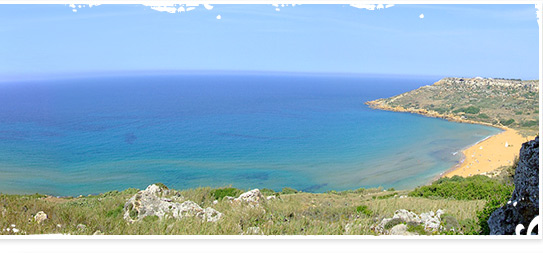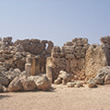

|
|
|
|
|
|
|
|
|
|
|
|



| |
| |
| |
Explore Gozo
Explore Gozo

Attractions in Gozo
Archeological Sites 
|
The Ggantija megalithic complex consists of two temples surrounded by a massive common boundary wall. One of the most striking features of the entire complex, the boundary wall, is built using the alternating header and stretcher technique, with some of the megaliths exceeding five metres in length and weighing over fifty tons. The temples at Ggantija are built with rough, coralline limestone blocks. Each temple contains five apses connected by a central corridor leading to the innermost trefoil section. The first temple is larger and contains a variety of features such as altars, relief carvings and libation holes. The second temple was built later and is devoid of such features. Also of interest is the corbelling technique evident on the inwardly inclined walls, suggesting that the temple was roofed. The gigantic dimensions of the megaliths have always struck a chord with popular imagination. In centuries past, some locals even believed that the Islands’ temples, in particular those of Ggantija, were the work of giants. This particular temple site in Gozo bears witness to this ancient legend: its name, Ggantija, is Maltese for giant.
The Xaghra Stone Circle was originally marked by two entrance monoliths which seem to have been 14 -16 feet high. Although the exact position has not been located, they seem to have been aligned with the Ggantija Temple. These monoliths together with several other megaliths formed part of a wall which circled the entire site. This circle was approximately 45 m in diameter. The interior is composed of a central ritual area entered through a huge stone threshold and down steps into the rough caves. The central chamber is subdivided into two distinct sections by a series of elegant megalithic trilithon altars and a massive stone bowl. Burials were concentrated in smaller caverns, surrounded by rough coralline stone walls. The most important discoveries from the Xaghra stone
circle may prove to be the rare but remarkably preserved human remains. Ta' Cenc Tombs The first consists of two rows of upright slabs, perhaps once the walls of a gallery grave. Close to them is a more typical dolmen, with a capstone supported on other blocks. The third is similar, built into a more recent field wall 600m to the east. There may once have been a fourth well off to the south east, but this can no longer be found. At Ta’ Tingi, several fine pairs can be found in the olive grove west of the pumping station, just south of Xewkija. An extensive system covers the Ta’ Cenc plateau, best seen between the hotel and the cliffs, and running near, but not to, Borg l-Imramma. They continue for nearly a kilometre to the east. An impressive pair zigzags down the slope from the San Lawrenz quarries to end on the cliffs above the Azure Widow at Dwejra. On the southern tip of the Victoria plateau, looking across towards Ta’ Sannat, the ruins of a temple lurk under carob trees. The scanty surviving walls suggest an original plan of five apses within an enclosing wall. The approach is by a path opposite the windmill tower. |
||||||
Gozo Directory
Useful Links - Archeological Sites:
Advertising & Webdesign | Contact Us
© Gozo.com 2007 - 2008


